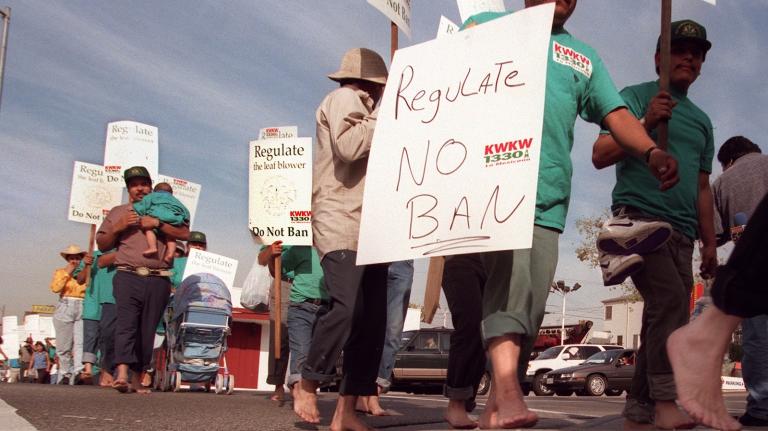
If my inbox and recent headlines are any indication, the green jobs bandwagon is rolling on jet fuel and it’s “game on” for labor market consultants. Having announced the imminent arrival of the green economy, we’re scrambling to define exactly what that means and to generate hard data about job descriptions, training requirements, hiring rates, salaries, and career paths.
These days, it seems like everyone is planning a “green jobs” study — but each will provide a much-needed service. These studies are helping employers, policymakers, and educators sort out hype from reality so that we can provide clearer direction to eco-job seekers.
Below, I take a closer look at what some of the most recent studies reveal:
State of the (green job) union
In January, Green Biz.com released State of Green Business 2008 (PDF), a report measuring progress on a “green biz index” that includes building energy use, carbon intensity, energy efficiency, green power use, paper use and recycling, pesticide use, toxic emissions, and 13 other green markers. It’s a must-read for would-be sustainability planners, managers, and technicians.
What’s the state of “green job creation” in 2008? It’s mentioned under the heading “Indicators We Wish We Had” with the following rueful comment: “How many jobs are being created through all of the kinds of activities measured in this report? No one knows.”
Although it’s true that “no one knows” is probably the most honest answer to the green jobs question, people everywhere are looking for answers and making projections. The idea that we could simultaneously attack the climate change crisis, pump up the economy, save money on energy costs, and provide “green collar jobs” is a tantalizing prospect. Governors and mayors with big hearts and small budgets have high hopes for all things green.
Links to some of the green jobs reports that are making the rounds can be found at the end of this post, but one thing is common to almost all of them. They agree that we need more detailed local and regional information from employers in six specific industries: green building, energy efficiency, solar energy, wind power, biofuels, and brownfields redevelopment.
Such good initial information may emerge through high profile national events like the “Good Jobs, Green Jobs: A National Green Jobs Conference” March 12-13 in Pittsburgh, sponsored by the BlueGreen Alliance.
On an international scale, environmental ministers from around the world are meeting in Monaco Feb. 20-22 to discuss ideas for financing a global transition to green jobs.
Traditional environmental industry seeks tech types for long-term relationships
Before there were “green jobs” in a “sustainable economy,” there were businesses and government agencies engaged in well-defined, environmentally related sectors. Surprise! The “old” environmental industry is still very much alive.
The December issue of the Environmental Business Journal provides the 2006 revenue and projected annual growth (2007-2010) numbers for the following sectors:
- Wastewater Treatment — $37.49 billion — 4.6 percent
- Solid Waste Management — $50.60 billion — 4.2 percent
- Remediation/Industrial Service — $11.55 billion — 4.4 percent
- Consulting and Engineering — $23.98 billion — 5.2 percent
- Water Equipment/Chemicals — $26.11 billion — 5.6 percent
- Water Utilities — $36.61 billion — 4.4 percent
- Resource Recovery — $24.13 billion — 15.0 percent
- Hazardous Waste Management — $ 8.99 billion — 2.2 percent
More importantly for job seekers, the companies and government agencies in all of these sectors report that “… finding, attracting, recruiting, hiring, training, and retaining qualified people …” was the biggest issue affecting the industry’s future and the most frequently mentioned concern affecting the growth potential of individual employers.
Environmental industry executives are deeply worried about where the next generation of qualified employees will come from. Government and corporate environmental officials are equally concerned, since a big part of their future personnel strategy involves outsourcing work to firms in these sectors while limiting the growth rate of government employment. With greater and greater frequency, working for “the government” means working for its contractors.
The EBJ numbers are supported by last year’s review of the top 200 environmental firms in Engineering News Record. ENR‘s analysis showed a 12.5 percent gain for the top 200 over the previous year, pushing total revenues for the big guys to $42.2 billion.
In a confirmation of our hopes for job creation in the clean energy and green building sector, EBJ reported that its definition of that industry grew a whopping 11.8 percent in 2006 to total revenues of $24.90 billion, with expected growth at 11.4 percent annually. Meanwhile, ENR has begun tracking the top “green contractors” in the nation.
Northern exposure
What kind of people do traditional environmental firms and agencies need? The answer comes from The Environmental Careers Organization of Canada, which reports that the “top ten green jobs” up north are:
- Environmental engineer
- Environmental technologist
- Conservation biologist
- Geographic Information System (GIS) analyst
- Air-quality specialists
- Environmental communication officers
- Stewardship coordinator
- Environmental specialist
- Research coordinator
- Environmental coordinator
With minor changes, these are exactly the same professionals that the U.S. environmental industry is searching for — and for the same reasons: growth (the environmental sector in Canada is growing at a rate that is 60 percent faster than the overall growth rate of Canada’s workforce) and aging (54 percent of environmental employees in management positions are 45 years of age or older).
Corporate social responsibility jobs are sustainable
A December study (PDF) from recruiter Ellen Weinreb and the business-student-focused nonprofit Net Impact reported that while corporate social responsibility and sustainability job postings were growing by up to 37 percent per year, the number of MBA-types seeking these positions was growing even faster, creating serious competition. The study analyzed both U.S. and European job postings, and the U.K. was by far the biggest marketplace for CSR-type positions.
So what?
What does this all mean for you, dear job seeker? Here are two takeaways for February:
Sometimes, the truth isn’t out there (yet)
The slow move to sustainability — and especially the climate change challenge — is creating whole new industries, new jobs, and new types of responsibilities within existing jobs. It’s happening in fits and starts, and we’re making it up as we go along. It will take a while for things to shake out, for people to agree on common job categories, and for useful year-on-year data to emerge.
You can’t always wait for hard data, agreed-upon job standards, certification requirements, accepted college degree programs, and so forth. Sometimes, you need to go with what you’ve got — and what you’ve got is people. So if your interest has been piqued by emerging job titles like campus sustainability coordinator, wind-energy installer, ecosystems management specialist, green-product marketer, conservation biologist, or sustainable-fisheries activist, make it your business to meet as many people as you can who are doing that work and learn from their stories. By the time the studies and statistics are good enough to tell the story, it may be your story they’ll be telling.
Find your own definition of “green”
A great deal of ink and electrons are being spilled (do electrons spill?) trying to figure out what counts as a “green” job and what doesn’t. For policy makers, activists, academics, and job-training professionals, that debate is essential. If people in the corn-based ethanol business or in “clean coal” get counted as “green,” for example, then jobs in those industries will start showing up in “green jobs” counts and may become eligible to receive programs and subsidies in the name of green economic development.
As a citizen, an environmentalist, a thinking person, and a Grist blogger, that’s important stuff. As a job seeker, however, do you really care? Consider the raging debates on Grist about our various energy, policy, and consumer choices and whether they are — or are not — really sustainable. There are some super-smart people in those debates and they often disagree. That disagreement isn’t going to end anytime soon. So develop a working definition of what kind of work counts as green for you; then get to work and watch as the green economy develops around you.
Questions? Log on and share them in comments.
- Renewable Energy and Energy Efficiency: Economic Drivers for the 21st Century (PDF) from the American Solar Energy Society (2007).
- Green Collar Jobs: An Analysis of the Capacity of Green Businesses to Provide High Quality Jobs for Men and Women with Barriers to Employment from the City of Berkeley, Calif. (2007).
- United Nations Background Paper on Green Jobs (PDF) from the United Nations Environment Programme (2008).
- Community Jobs in the Green Economy from the Apollo Alliance and Urban Habitat (2007).
- Capturing the Energy Opportunity: Creating a Low-Carbon Economy (PDF) from the Center for American Progress (2007).
- Massachusetts Clean Energy Industry Census (PDF) from the Massachusetts Technology Collaborative (2007).
 Kevin Doyle is the president of Green Economy, a Boston-based training, consulting, and research firm with services for the institutions and individuals building a more sustainable world. He is coauthor of The ECO Guide to Careers That Make a Difference: Environmental Work for a Sustainable World and is currently at work on a new book about climate-change careers.
Kevin Doyle is the president of Green Economy, a Boston-based training, consulting, and research firm with services for the institutions and individuals building a more sustainable world. He is coauthor of The ECO Guide to Careers That Make a Difference: Environmental Work for a Sustainable World and is currently at work on a new book about climate-change careers.


